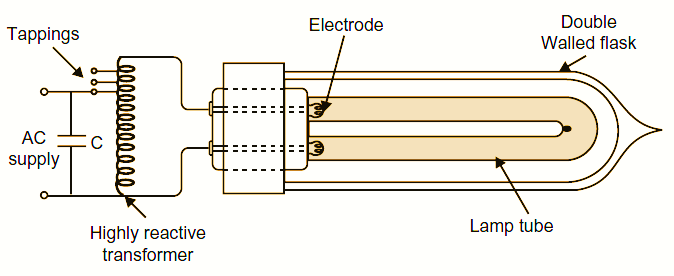It is also the gas discharge lamp in which sodium is used, so this is called as the sodium vapour lamp.

Fig. 1. Sodium Vapour Lamp.
Construction of Sodium Vapour Lamp
The Fig. 1 shows the construction of the sodium vapour lamp. It has a U-shape tube (or Lamp tube) made of hard glass. This tube contains two oxide coated electrodes at both the ends. There is neon gas at low pressure in the tube. There are few drops of sodium in the tube. The U tube is enclosed in a double walled vacuum tube to keep the temperature within working range. The inner tube can be taken out for testing etc. The two ends of the electrodes are brought to the bayonet cap. It is connected across the secondary of a high leakage reactance transformer. The transformer offers high voltage at the time of starting and low voltage in running condition. A condenser is also connected to improve the power factor.
Working of Sodium Vapour Lamp
The lamp requires high voltage at the time of starting i.e. switching on, which is obtained from the high leakage transformer. The discharge takes place through the neon gas and is of pink colour. The gas is heated up and sodium is vaporised. A yellowish light is produced when sodium vapours also takes part. Now the resistance of the lamp decreases and the current increases but the voltage is dropped and controlled by the high leakage transformer. The lamp works at low voltage and the working temperature is about 300°C.
General information of Sodium Vapour Lamp
- The lamp has yellowish light.
- It takes about ten minutes to give full light.
- It must be used in horizontal position otherwise the sodium drops may come to the bottom of the tube.
- The transformer must be high leakage transformer and its power should be according to the lamp.
- In its light the colour cannot be judged properly.
- It can work on A.C. only.
Uses of Sodium Vapour Lamp
The lamps are available in different wattage 40 W, 60 W etc. and are used for decoration purpose and street lighting purpose etc.